Automotive Carbon Fiber Composites Market Size
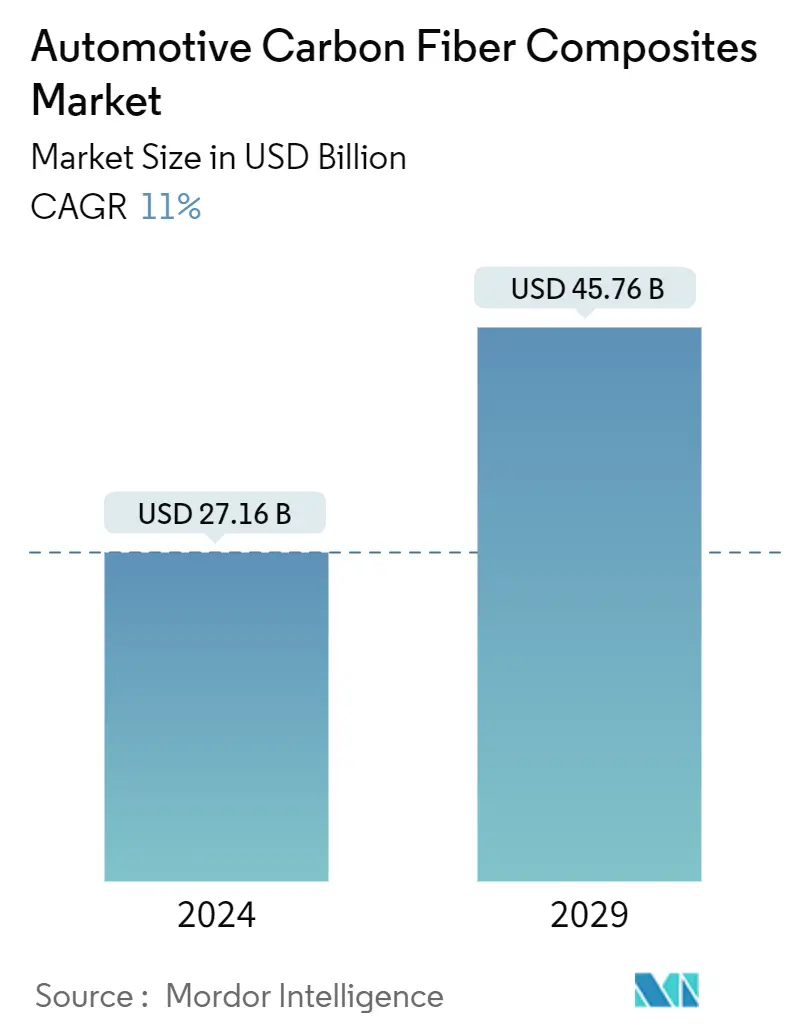
| Study Period | 2019 - 2029 |
| Market Size (2024) | USD 27.16 Billion |
| Market Size (2029) | USD 45.76 Billion |
| CAGR (2024 - 2029) | 11.00 % |
| Fastest Growing Market | Asia Pacific |
| Largest Market | Europe |
Major Players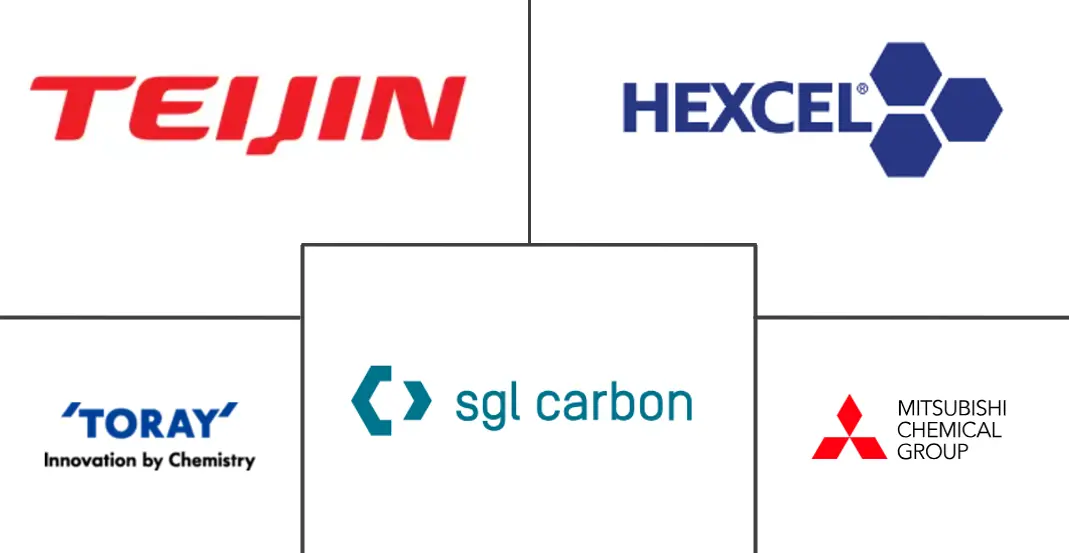
*Disclaimer: Major Players sorted in no particular order |
Need a report that reflects how COVID-19 has impacted this market and its growth?
Automotive Carbon Fiber Composites Market Analysis
The Automotive Carbon Fiber Composites Market size is estimated at USD 27.16 billion in 2024, and is expected to reach USD 45.76 billion by 2029, growing at a CAGR of 11% during the forecast period (2024-2029).
Over the medium term, rising demand for lightweight material from the automotive industry and growing focus on fuel economy are expected to be major drivers for the automotive carbon fiber market. However, high costs associated with carbon fiber composites and glass fiber composites are hindering the market's growth, as their usage in low-cost vehicles could drastically increase the prices of such vehicles.
Carbon fiber is a lightweight material with high-strength characteristics that can be designed for enhanced performance in automotive applications. It offers improvements in structural, functional, or cosmetic properties. To make vehicles lighter, cleaner, safer, and more cost-effective, leading carbon fiber suppliers are responding to the needs and expectations of vehicle OEMs, system suppliers, and customers.
Major car companies, such as BMW, Audi, GM, Honda, and Polestar, have established agreements with carbon fiber material producers for mass production and are investing in their processes to support low-cost carbon fiber manufacturing.
Amid increasingly stringent emission norms and rising fuel prices, carbon fiber is proving a great alternative to conventional metals as it can reduce the vehicle's weight. This can improve the fuel efficiency and performance of the engine while the fiber's physical strength limits are almost twice as high as those of conventional metals. The rise in demand for electric vehicles worldwide is likely to enhance the penetration of carbon fiber to improve the range of electric vehicles, which, in turn, is likely to result in major growth for the market during the forecast period.
Automotive Carbon Fiber Composites Market Trends
Passenger Car Segment Holds a Major Market Share
The rise in passenger vehicle sales worldwide has been in line with an increase in consumers' disposable incomes and buying capacities. An increase in vehicle electrification is likely to enhance the demand for lightweight vehicles, which is likely to result in major growth for the market during the forecast period.
The rise in demand for electric vehicles owing to the enactment of stringent emission norms globally is likely to increase the integration of lightweight parts that are fabricated from composite materials.
Due to the growing concerns over environmental issues caused by the rise in exhaust emissions, there has been an increasing demand for high-performance electric vehicles. This has been further supported by the introduction of strict regulations regarding emissions and fuel economy, as well as government initiatives such as subsidies and incentives to encourage the adoption of electric vehicles.
Increasing investments and rising government initiatives to promote the adoption of EVs, combined with the growing demand for sustainable transportation solutions and decreasing costs of EVs and their components, are also expected to drive market growth in the coming years.
Advanced materials such as carbon fiber are essential for boosting the fuel economy of modern cars and maintaining performance and safety. Since it takes less energy to accelerate a lighter object than a heavier one, lightweight materials offer great potential for optimizing vehicle efficiency and fuel economy. A 10% reduction in the vehicle's weight can transpire to a 6-8% increase in fuel economy.
In recent years, automotive parts have witnessed advancements and innovations with the evolution of new technologies. Among them, the use of lightweight materials for the manufacturing of auto components has been gaining attention globally.
In a typical automobile, fiber is 50% by volume while adding just 10% to the weight. The UK government recently declared plans to cut 68% of CO2 emissions by 2030 in a proposal to tackle climate change and announced a ban on gasoline and diesel cars from 2030.
Major players worldwide are investing in the research and development of carbon fiber components to enhance vehicle efficiency. For instance,
- In November 2022, Ahera, an ultra-premium electric automotive brand, revealed the exterior design of the first model of its SUV. The vehicle is made up of highly sustainable composite material, including forged carbon fiber.
- In October 2022, Nissan Motors showcased its Frontier pickup truck powered by a 5.6-liter V-8 engine and integrated with a wide-body kit featuring carbon-fiber front fenders and bedsides, along with a carbon hood.
Considering these aforementioned factors and developments, the demand for highly efficient carbon fiber in passenger cars is anticipated to register high growth during the forecast period.
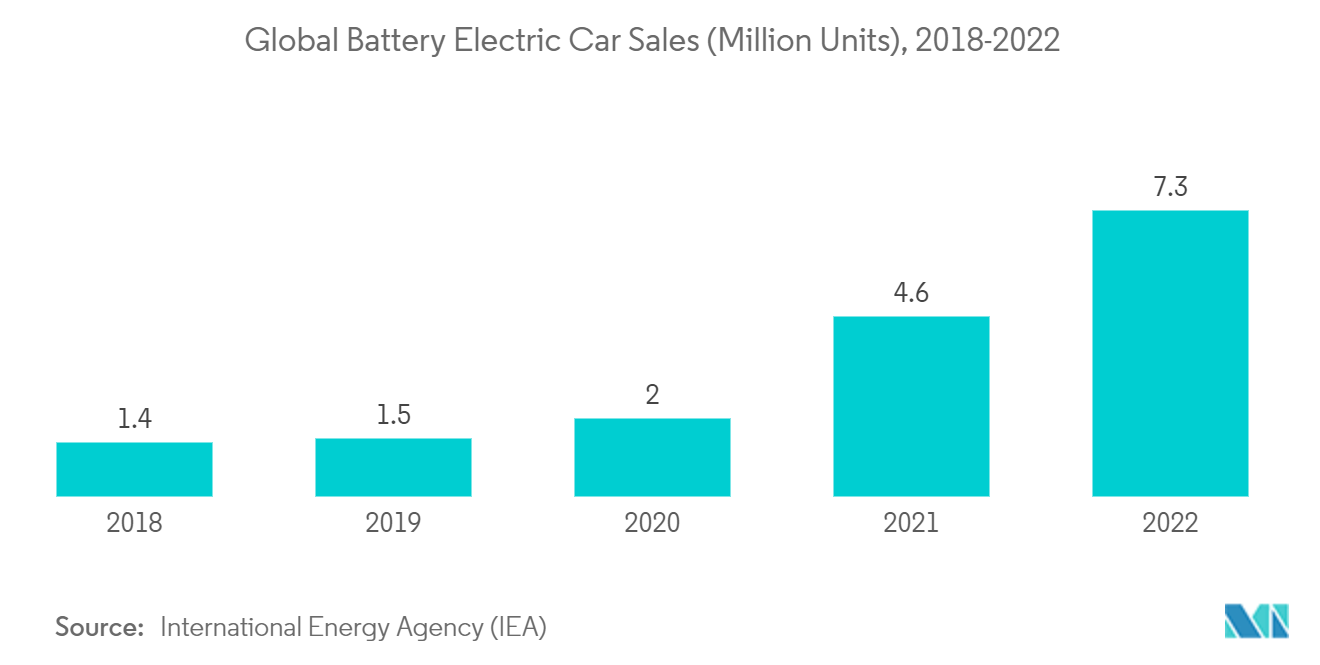
Europe Dominating the Market
Luxury cars and sports cars are anticipated to hold high potential for the usage of carbon fiber. Europe is projected to be the leading region in terms of strong demand for luxury cars and sports cars.
The European luxury car market is expected to be driven by SUVs over the coming years, while traditional passenger cars lose their market share. It is a global trend that started in the United States and then spread to Europe and Asia. Some of the brands whose bestseller SUVs are sold in Europe include Nissan, Hyundai, Kia, Mazda, Mitsubishi, Jaguar, Lexus, Porsche, Maserati, and Volvo. These vehicle sales are expected to drive the demand for automotive air suspension over the coming years.
The automotive industry in the United Kingdom is now best known for premium and sports car manufacturers, including Aston Martin, Bentley, Daimler, Jaguar, Lagonda, Land Rover, Lotus, McLaren, MG, Mini, Morgan, and Rolls-Royce. The country's passenger car sales amounted to 12.64 units in 2022. This growth has been backed by the launch of these OEMs' latest models, which have embedded the advanced body material.
With the enactment of stringent emission norms and fuel economy standards in European countries, automobile manufacturers in Germany, Italy, and France, such as BMW, Volkswagen, and Audi, have started using carbon fiber composites in manufacturing vehicles.
Companies are trying to invent new parts made of carbon fiber that can reduce a vehicle's total weight to a great extent. The application of carbon-fiber-reinforced plastic (CFRP) has been widely adopted for the production of automotive bodies, particularly by hyper-car manufacturers such as Ferrari, Lamborghini, and Porsche.
In line with the abovementioned factors, the demand for carbon fiber for automotive parts is anticipated to register a high growth rate in Europe due to luxury and sports car sales.
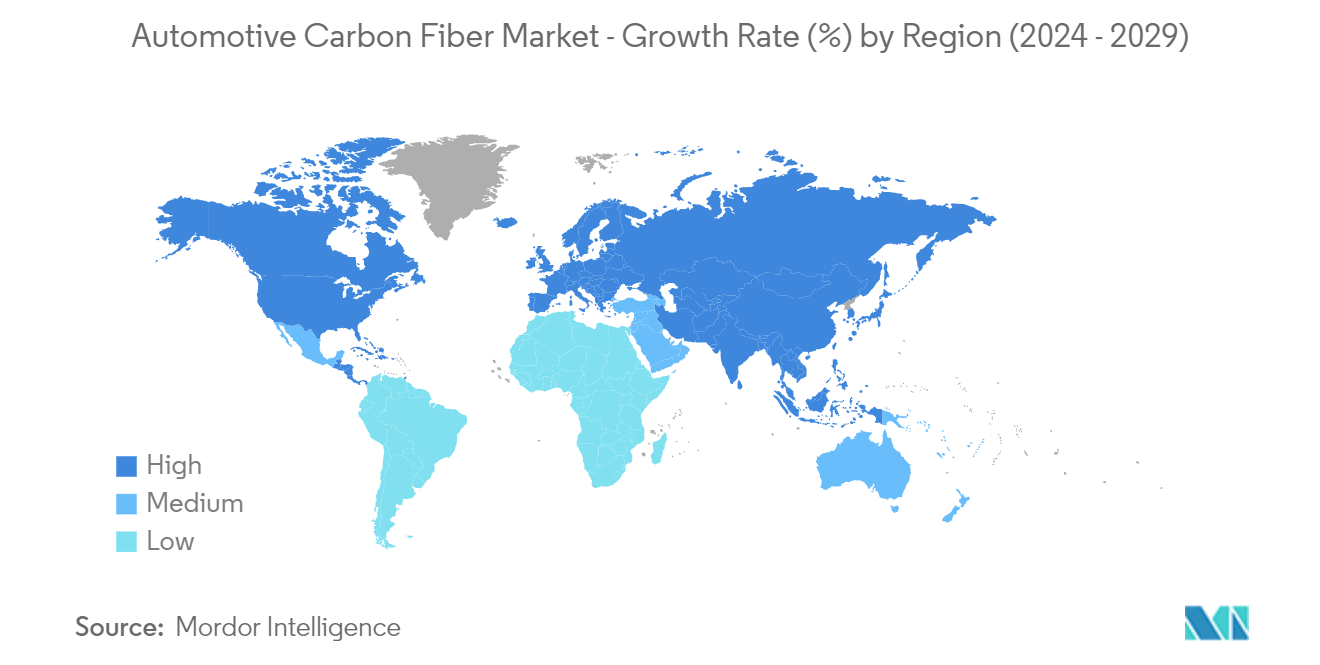
Automotive Carbon Fiber Composites Industry Overview
The automotive carbon fiber market is dominated by several key players, such as Hexcel Corporation, Mitsubishi Chemical Group, SGL Carbon SE, Teijin Limited, and Toray Industries Inc. The demand is on the positive side, attributed to strong expansion and growth strategies adopted by leading carbon fiber manufacturers. For instance,
- In November 2023, Carbon Revolution, one of the leading carbon fiber companies in Australia, expanded its manufacturing facility in Mexico. Through this expansion, the company expanded its carbon-fiber wheel services across the country.
- In October 2023, Mitsubishi Chemical Group and Honda Motor Company jointly developed polymethyl methacrylate, also called acrylic resin material for automotive body parts. The new material will be used in vehicle doors, hoods, fenders, and other automotive body parts.
Automotive Carbon Fiber Composites Market Leaders
Toray Industries Inc.
Hexcel Corporation
SGL Carbon SE
Teijin Limited
Mitsubishi Chemical Corporation.
*Disclaimer: Major Players sorted in no particular order
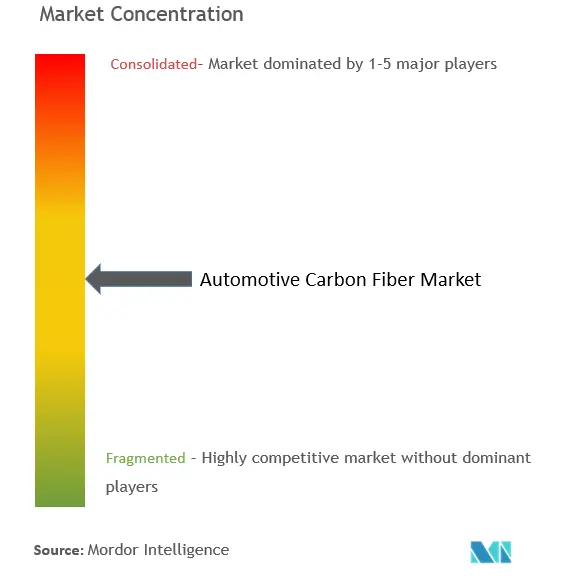
Automotive Carbon Fiber Composites Market News
- December 2023: Teijin Limited announced plans to start producing and selling Tenax carbon fiber made from environmentally friendly materials. This material helps in the reduction of greenhouse gas emissions throughout the product's life cycle.
- December 2023: Foton Motor introduced a super low-carbon truck, the Toano V next-generation light bus, and a full range of hybrid vehicles.
- October 2023: Toray Industries Inc. developed TORAYCA T1200 carbon fiber, which boasts the highest strength of 1,160 kilopounds per square inch (Ksi). This advancement will aid the company in reducing its environmental footprint by using lighter carbon-fiber-reinforced plastic materials.
Automotive Carbon Fiber Market Report - Table of Contents
1. INTRODUCTION
1.1 Study Assumptions
1.2 Scope of the Study
2. RESEARCH METHODOLOGY
3. EXECUTIVE SUMMARY
4. MARKET DYNAMICS
4.1 Market Drivers
4.1.1 Rising Demand for Lightweight Materials from the Automotive industry
4.2 Market Restraints
4.2.1 High Processing and Manufacturing Cost of Composites
4.3 Industry Attractiveness - Porter's Five Forces' Analysis
4.3.1 Bargaining Power of Suppliers
4.3.2 Bargaining Power of Buyers/Consumers
4.3.3 Threat of New Entrants
4.3.4 Intensity of Competitive Rivalry
4.3.5 Threat of Substitute Products
5. MARKET SEGMENTATION (Market Size in Value- USD)
5.1 By Application
5.1.1 Structural Assembly
5.1.2 Powertrain Components
5.1.3 Interiors
5.1.4 Exteriors
5.2 By Vehicle Type
5.2.1 Passenger Car
5.2.2 Commercial Vehicle
5.3 By Propulsion
5.3.1 Internal Combustion Engine
5.3.2 Battery Electric Vehicles
5.3.3 Hybrid Electric Vehicles
5.3.4 Plug-in Hybrid Electric Vehicles
5.3.5 Fuel Cell Electric Vehicles
5.4 By Geography
5.4.1 North America
5.4.1.1 United States
5.4.1.2 Canada
5.4.1.3 Rest of North America
5.4.2 Europe
5.4.2.1 Germany
5.4.2.2 United Kingdom
5.4.2.3 France
5.4.2.4 Italy
5.4.2.5 Rest of Europe
5.4.3 Asia-Pacific
5.4.3.1 China
5.4.3.2 Japan
5.4.3.3 India
5.4.3.4 South Korea
5.4.3.5 Rest of Asia-Pacific
5.4.4 Rest of the World
5.4.4.1 South America
5.4.4.2 Middle East and Africa
6. COMPETITIVE LANDSCAPE
6.1 Vendor Market Share
6.2 Company Profiles*
6.2.1 Toray Industries Inc.
6.2.2 Hexcel Corporation
6.2.3 Mitsubishi Chemical Corporation
6.2.4 SGL Carbon SE
6.2.5 Teijin Ltd
6.2.6 BASF SE
6.2.7 Solvay SA
6.2.8 Bcomp Ltd
6.2.9 Dow Inc.
6.2.10 Nippon Sheet Glass Co. Ltd
6.2.11 BFG International Group
7. MARKET OPPORTUNITIES AND FUTURE TRENDS
Automotive Carbon Fiber Composites Industry Segmentation
Carbon fiber is a lightweight material with high-strength characteristics that can be designed for enhanced performance in automotive applications.
The automotive carbon fiber market is segmented by application, vehicle type, propulsion, and geography. By application, the market is segmented into structural assembly, powertrain components, interiors, and exteriors. By vehicle type, the market is segmented into passenger cars and commercial vehicles. By propulsion, the market is segmented into internal combustion engines, battery electric vehicles, hybrid electric vehicles, plug-in hybrid electric vehicles, and fuel cell electric vehicles. By geography, the market is segmented into North America, Europe, Asia-Pacific, and Rest of the World. For each segment, the market sizing and forecast have been done based on the value (USD).
| By Application | |
| Structural Assembly | |
| Powertrain Components | |
| Interiors | |
| Exteriors |
| By Vehicle Type | |
| Passenger Car | |
| Commercial Vehicle |
| By Propulsion | |
| Internal Combustion Engine | |
| Battery Electric Vehicles | |
| Hybrid Electric Vehicles | |
| Plug-in Hybrid Electric Vehicles | |
| Fuel Cell Electric Vehicles |
| By Geography | |||||||
| |||||||
| |||||||
| |||||||
|
Automotive Carbon Fiber Market Research FAQs
How big is the Automotive Carbon Fiber Composites Market?
The Automotive Carbon Fiber Composites Market size is expected to reach USD 27.16 billion in 2024 and grow at a CAGR of 11% to reach USD 45.76 billion by 2029.
What is the current Automotive Carbon Fiber Composites Market size?
In 2024, the Automotive Carbon Fiber Composites Market size is expected to reach USD 27.16 billion.
Who are the key players in Automotive Carbon Fiber Composites Market?
Toray Industries Inc., Hexcel Corporation, SGL Carbon SE, Teijin Limited and Mitsubishi Chemical Corporation. are the major companies operating in the Automotive Carbon Fiber Composites Market.
Which is the fastest growing region in Automotive Carbon Fiber Composites Market?
Asia Pacific is estimated to grow at the highest CAGR over the forecast period (2024-2029).
Which region has the biggest share in Automotive Carbon Fiber Composites Market?
In 2024, the Europe accounts for the largest market share in Automotive Carbon Fiber Composites Market.
What years does this Automotive Carbon Fiber Composites Market cover, and what was the market size in 2023?
In 2023, the Automotive Carbon Fiber Composites Market size was estimated at USD 24.17 billion. The report covers the Automotive Carbon Fiber Composites Market historical market size for years: 2019, 2020, 2021, 2022 and 2023. The report also forecasts the Automotive Carbon Fiber Composites Market size for years: 2024, 2025, 2026, 2027, 2028 and 2029.
Carbon Fiber in Automotive Industry Report
Statistics for the 2024 Carbon Fiber in Automotive market share, size and revenue growth rate, created by Mordor Intelligence™ Industry Reports. Carbon Fiber in Automotive analysis includes a market forecast outlook to 2029 and historical overview. Get a sample of this industry analysis as a free report PDF download.
